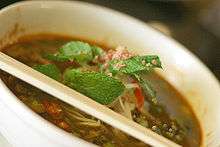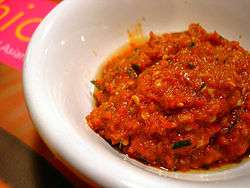Peranakan cuisine

 |
| This article is part of the series |
| Chinese cuisine |
|---|
|
Regional cuisines
|
|
Ingredients and types of food |
|
|
Peranakan or Nyonya cuisine comes from the Peranakans, descendants of early Chinese migrants who settled in Penang, Malacca, Singapore and Indonesia inter-marrying with local Malays and combines Chinese, Malay and other influences. The old Malay word nonya (also spelled nyonya), a term of respect and affection for women of prominent social standing (part “madame” and part “auntie”), has come to refer to the cuisine of the Peranakans.
Nonya cooking is the result of blending Chinese ingredients with various distinct spices and cooking techniques used by the Malay/Indonesian community. This gives rise to Peranakan interpretations of Malay/Indonesian food that is similarly tangy, aromatic, spicy and herbal. In other instances, the Peranakans have adopted Malay cuisine as part of their taste palate, such as assam fish and beef rendang. Key ingredients include coconut milk, galangal (a subtle, mustard-scented rhizome similar to ginger), candlenuts as both a flavoring and thickening agent, laksa leaf, pandan leaves (Pandanus amaryllifolius), belachan, tamarind juice, lemongrass, torch ginger bud, jicama, fragrant kaffir lime leaf, rice or egg noodles and cincaluk - a powerfully flavored, sour and salty shrimp-based condiment that is typically mixed with lime juice, chillies and shallots and eaten with rice, fried fish and other side dishes.
There are regional variations in Nonya cooking. Dishes from the island of Penang in the northern part of Peninsular Malaysia possess Thai influences, such as more liberal use of tamarind and other sour ingredients. Dishes from Singapore and Malacca show a greater Indonesian influence, such as the use of coconut milk. A classic example is laksa (a spicy noodle soup), which comes in two variants: the sour asam laksa from Penang and the coconut milk-based laksa lemak from Singapore and the southern regions of Peninsular Malaysia.
The flavor of laksa and other Nonya recipes is determined by the rempah, which in Malay means spices. The various combinations are pounded into a paste with pestle and mortar, with a very specific texture and density. It is said that a nonya can determine the culinary skill of a new daughter-in-law simply by listening to her preparing rempah with a mortar. Nonya recipes are handed down from one generation to the next, and because of the time-consuming preparation of these dishes, it is a cuisine that is often at its best when served at home. Laksa is a notable exception to this rule.
Examples of Nonya specialities include otak-otak, a popular blend of fish, coconut milk, chilli paste, galangal, and herbs wrapped in a banana leaf;[1] Ayam Buah Keluak, a distinctive dish combining chicken pieces with nuts from the Pangium edule or kepayang tree to produce a rich sauce; and Itek Tim, a classic soup containing duck, tomatoes, green peppers, salted vegetables, and preserved sour plums simmered gently together.
Nonya desserts include colourful cakes (kuih) and sweet, sticky delicacies.
List of Nonya dishes

- Acar - various pickled meats and vegetables like acar keat lah (honey lime/calamansi), achar hu (fried fish), acar kiam hu (salt fish), acar timun (cucumber), acar awat (mixed vegetables).
- Asam Laksa. Considered one of Penang's three signature dishes, Asam laksa consists of a bowl of translucent white rice noodles served in a spicy soup made of fish (usually mackerel), tamarind (both asam jawa and asam gelugor), and daun kesum. Toppings may include onion, mint, chopped torch ginger flower, and slices of pineapple and cucumber. A dollop of pungent, viscous shrimp paste is usually served on the side.
- Ayam buah keluak, a chicken dish cooked using the nuts from Pangium edule or the "Kepayang" tree, a mangrove tree that grows in Malaysia and Indonesia.
- Ayam pongteh, a chicken stew cooked with tauchu or salted fermented soy beans, and gula melaka. It is usually salty-sweet and can be substituted as a soup dish in Peranakan cuisine.
- Babi assam, a pork stew cooked with tamarind juice. This dish is also popular within the Kristang community.
- Bak Chang, Nonya-style zongzi made in a similar manner as a typical southern Chinese zongzi. However, the filling is typically minced pork with candied winter melon, ground roasted peanuts, and a spice mix. The blue peaflower is used to colour the rice with a shade of blue, and pandan leaves are sometimes used as the wrapping instead.
- Cap cai, stir fried vegetables. The Nonya version of this Chinese Indonesian classic incorporates tauchu and dried shrimp.
- Cincalok, a distinctly Malaccan condiment made of fermented tiny shrimp (udang geragau), salt and rice. It is also a favoured cooking ingredient used by the Kristang Eurasian community of Malacca.
- Enche Kabin, deep fried chicken pieces marinated in a paste of coconut milk and rempah.
- Kari Kapitan, a Nonya take on the ubiquitous chicken curry. Kaffir lime leaves and coconut milk are among the key ingredients for this mild curry.
- Itek Tim or Kiam Chye Ark Th'ng is a soup of duck, preserved mustard greens and cabbage flavoured with nutmeg, Chinese mushrooms, tomatoes and peppercorns.
- Jiew Hu Char is a dish made up mainly of shredded vegetables like turnip or jicama, carrot, and cabbage and fried together with thinly shredded dried cuttlefish.
- Kerabu Bee Hoon is a salad dish consisting of rice vermicelli mixed with sambal belacan, calamansi lime juice, and finely chopped herbs and spices. Other famous salad dishes are kerabu bok née (cloud ear fungus/tikus telinga), kerabu kay (chicken), kerabu kay khar (chicken feet), kerabu timun (cucumber), kerabu kobis (cabbage), kerabu kacang botol (four angled bean), kerabu bak poey (pork skin).
- Kiam Chye Boey is a mixture of leftovers from Kiam Chye Ark Th'ng, Jiew Hu Char, Tu Thor Th'ng and various other dishes. "Boey" literally means "end".
- Laksa lemak is a type of laksa served in a rich coconut gravy, served with prawns, cockles, lime and a dollop of sambal belacan.
- Lam mee is long yellow noodles cooked in a rich gravy made from a stock of prawns and chicken. It is always served at birthdays to wish the birthday boy or girl a long life, and thus it is also known as birthday noodles.
- Lontong Cap Go Meh is a Peranakan Chinese Indonesian take on the traditional Indonesian dish.
- Masak titik is a style of vegetable soup that makes liberal use of white peppercorns. One version uses watermelon rind as the main ingredient. Another makes use of green or semi ripe papaya.
- Mee siam dish of fried thin rice vermicelli with spicy gravy.
- Nasi kunyit is glutinous rice seasoned with turmeric powder, coconut milk and asam gelugor. It is usually served with a chicken curry, ang koo kueh, and pink-dyed hard-boiled eggs as gifts in celebration of a child of friends and family turning one month old.
- Otak-otak is a dish involving fish pieces wrapped in banana leaves. Two very different variations exist: one consists of a mixture of fish pieces and spice paste wrapped in banana leaves and char grilled.
- Perut ikan - a spicy stew (similar to asam pedas in flavour profile) comprising mainly vegetables/herbs and getting its distinctive taste mainly from fish bellies preserved in brine and daun kaduk (the Wild Pepper leaf is from the Piper stylosum or the Piper sarmentosum). A classic Penang Nonya dish.
- Pie Tee is a thin and crispy pastry tart shell filled with a spicy, sweet mixture of thinly sliced vegetables and prawns.
- Seh Bak - a dish of pork loin, marinated overnight with herbs and spices, cooked over a slow fire and simmered to tenderness.
- Swikee is a Peranakan frog leg soup dish, popularly associated with the town of Jatiwangi and Purwodadi in Java, Indonesia.
- Ter Thor T'ng - literally pig stomach soup, this dish requires a skilled cook to prepare and deodorise the ingredients using salt before cooking. Its main ingredients are pig stomach and white peppercorns.
See also
References
- ↑ Eveland, Jennifer (2007). Frommer's Singapore & Malaysia. Frommer's. p. 98. ISBN 978-0-470-10049-3.
| Wikimedia Commons has media related to Peranakan cuisine. |